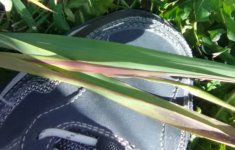0_o
ⁿ°ⁿ↔ρ└ªγ³r κhªrªκτ³r
An enormous and diverse patch of Phalaris arundinacea grows near where I live right now. Many of the new leaves near the top show red pigments at their margins. A few leaves caught my eye however, they had red/purple colors.
The uppermost leaves are where alkaloids are found in the largest concentration and at this time the alkaloid levels are at their highest in literature. The plants are a bit drought stressed as well.
There are visible patches of different phenotypes here, some are a bit taller, some have more purple in their inflorescence than others. Something looking like P. aquatica is in the area as well.
I chew on the leaves of the P. arundinacea, just the top two leaves. They are often sweet but these were salty. Go figure.
The uppermost leaves are where alkaloids are found in the largest concentration and at this time the alkaloid levels are at their highest in literature. The plants are a bit drought stressed as well.
There are visible patches of different phenotypes here, some are a bit taller, some have more purple in their inflorescence than others. Something looking like P. aquatica is in the area as well.
I chew on the leaves of the P. arundinacea, just the top two leaves. They are often sweet but these were salty. Go figure.

